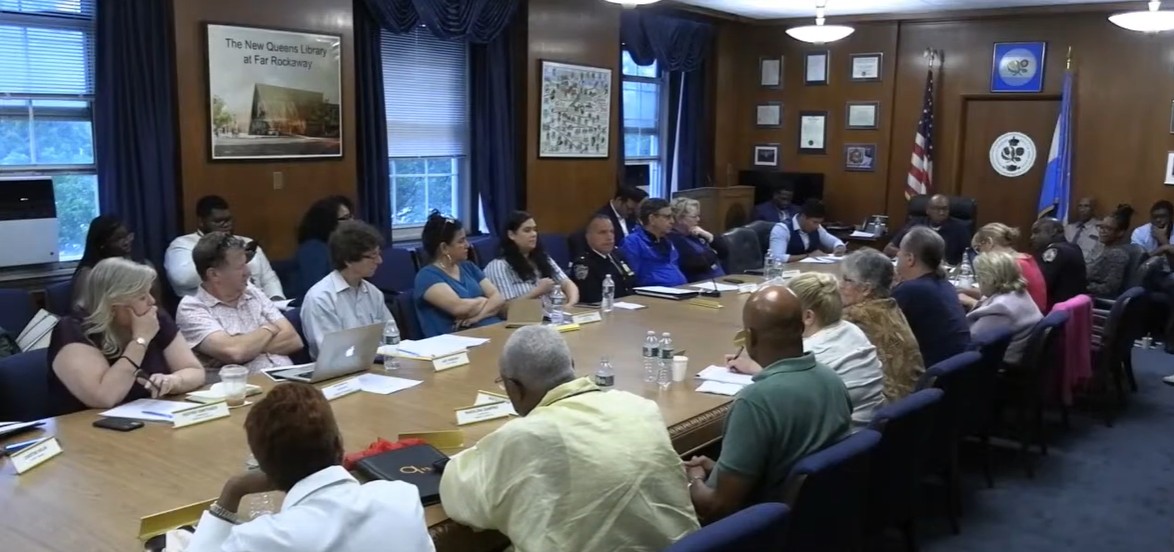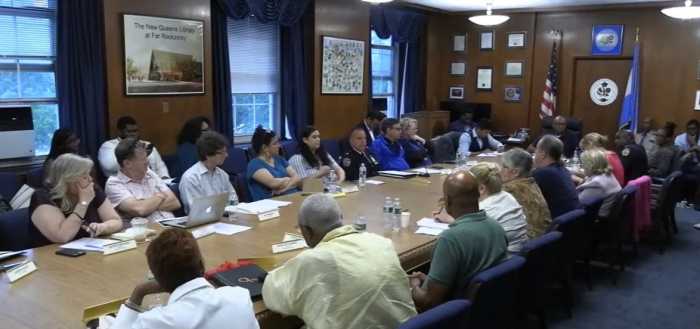The Queensbridge Houses are in the same borough where President Donald Trump grew up — just a 50-minute F-train trip away.
It’s the largest public housing complex in the country, and its residents have been through a lot.
Tenant Association president April Simpson, 55, remembers the “walking dead” of crack epidemic years. Raymond B. Normandeau, a resident since the 1970s, remembers when you’d hear gunshots every few days. Just a few years ago, he remembers hearing shots once a week.
Conditions have often been deplorable. Normandeau, 73, points to tile bulging from his bathroom walls. He says he put in a request for the New York City Housing Authority to fix it in October. He’s still waiting.
On the surface, these descriptions seem to back up Trump’s talk of the “inner-city,” where residents are “living in hell.” He has often promised that he alone can fix the dire conditions.
Except there’s one problem: Things have begun to turn around at Queensbridge, due to the combined work of residents, government agencies, social workers, police. A long-delayed project to replace the roofs started in 2015 and was completed last year, ahead of schedule. After the introduction of an antiviolence program in which workers talk down shooters, the development celebrated a year without a shooting last month.
NYCHA needs support, not a wrecking ball
“We made big strides here in Queensbridge,” says Taylonn Murphy, one of the “violence interrupters,” adding that programs like it should be looked at by all levels of government.
Unfortunately, NYCHA is staring down new cuts in federal funding under Trump. That’s serious news for an agency dependent on the federal government to fund $2 billion of a $3.2 billion operating budget.
The Department of Housing and Urban Development directed the agency to belt-tighten for the remainder of the year: including some $35 million in administrative fees that will be an immediate loss, plus $40 million in cuts to Section 8 housing payments. And early drafts of the president’s budget suggest even larger cuts ahead.
NYCHA is scrambling to figure out how to manage the cuts, as chair Shola Olatoye will discuss at a City Council budget hearing Monday. Officials say tenants could experience even longer wait times before getting that sink or elevator or bathroom tile fixed. Wait times can already be long: a 2015 report by city Comptroller Scott Stringer found completed repairs took an average of 35 days.
Budget shortfalls aren’t a new experience for NYCHA, which also has endured periods of mismanagement and lack of attention. It has a capital repairs deficit of some $17 billion, and often gets less money than it needs from the federal government. In a public housing operations funding stream, the agency has received an average of 92 percent of its need from 2001 to 2016. That includes an 82 percent low in 2013 during budget fights. This year the federal government funded 85 percent of what NYCHA requested.
Long-term underinvestment comes with costs — for example, problems due to a leaky roof escalate quickly, because water gets into the walls, as was the case for Simpson at Queensbridge. She was having problems with her TV cutting out and when the cable guy came to look, he found water dripping behind the wall socket.
In 2015, the city stepped in, adding $60 million to the federal allowance of $27 million for the roof project. But there’s just not enough local money lying around to meet all of NYCHA’s need, and mayors Michael Bloomberg and Bill de Blasio have considered elements of privatization plans to find alternate funds.
It doesn’t need to be this way
Trump may not have spent much time across the borough in Queensbridge, but he is familiar with public housing — his father’s real estate empire included subsidized construction.
The son says he wants to fix blight in urban communities. Well, he could decide not to eliminate billions of dollars from community development programs, as HUD’s leaked draft budget indicated.
That would be constructive, rather than the language and philosophy we’ve heard so far from HUD Secretary Ben Carson, who spoke in confirmation hearings about the “generation after generation living in dependent situations.” Or from Trump himself, who regularly falls back on the old stereotypes of people on welfare, needing to go back to work.
“People think people living in the projects have no values, no morals,” says Simpson, the tenant association president. She says her mother was a teacher and raised seven kids. Her father was a maintenance worker at NYU. They lived and retired in Queensbridge, like many other elderly individuals in the development not able to afford housing elsewhere in the city.
That disparity is getting worse, even as much of the city gains in wealth and safety. New hotels and fancy buildings create jobs and opportunities in nearby Long Island City, which feels a world away from Queensbridge and its efforts to keep itself moving up.
“And now they want to take money from government housing developments?” Simpson asks. “Are they serious?”

































